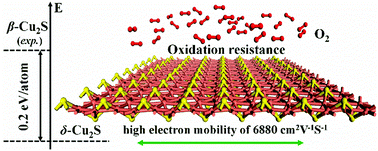当前位置:
X-MOL 学术
›
Nanoscale Horiz.
›
论文详情
Our official English website, www.x-mol.net, welcomes your feedback! (Note: you will need to create a separate account there.)
Copper(i) sulfide: a two-dimensional semiconductor with superior oxidation resistance and high carrier mobility†
Nanoscale Horizons ( IF 9.7 ) Pub Date : 2018-09-19 00:00:00 , DOI: 10.1039/c8nh00216a Yu Guo 1, 2, 3, 4, 5 , Qisheng Wu 6, 7, 8, 9, 10 , Yunhai Li 5, 10, 11, 12 , Ning Lu 5, 13, 14, 15, 16 , Keke Mao 6, 7, 8, 9, 17 , Yizhen Bai 1, 2, 3, 4, 5 , Jijun Zhao 1, 2, 3, 4, 5 , Jinlan Wang 5, 10, 11, 12, 18 , Xiao Cheng Zeng 6, 7, 8, 9, 19
Nanoscale Horizons ( IF 9.7 ) Pub Date : 2018-09-19 00:00:00 , DOI: 10.1039/c8nh00216a Yu Guo 1, 2, 3, 4, 5 , Qisheng Wu 6, 7, 8, 9, 10 , Yunhai Li 5, 10, 11, 12 , Ning Lu 5, 13, 14, 15, 16 , Keke Mao 6, 7, 8, 9, 17 , Yizhen Bai 1, 2, 3, 4, 5 , Jijun Zhao 1, 2, 3, 4, 5 , Jinlan Wang 5, 10, 11, 12, 18 , Xiao Cheng Zeng 6, 7, 8, 9, 19
Affiliation

|
Two-dimensional (2D) semiconductors with suitable direct band gaps, high carrier mobility, and excellent open-air stability are especially desirable for material applications. Herein, we show theoretical evidence of a new phase of a copper(I) sulfide (Cu2S) monolayer, denoted δ-Cu2S, with both novel electronic properties and superior oxidation resistance. We find that both monolayer and bilayer δ-Cu2S have much lower formation energy than the known β-Cu2S phase. Given that β-Cu2S sheets have been recently synthesized in the laboratory (Adv. Mater.2016, 28, 8271), the higher stability of δ-Cu2S than that of β-Cu2S sheets suggests a high possibility of experimental realization of δ-Cu2S. Stability analysis indicates that δ-Cu2S is dynamically and thermally stable. Notably, δ-Cu2S exhibits superior oxidation resistance, due to the high activation energy of 1.98 eV for the chemisorption of O2 on δ-Cu2S. On its electronic properties, δ-Cu2S is a semiconductor with a modest direct band gap (1.26 eV) and an ultrahigh electron mobility of up to 6880 cm2 V−1 s−1, about 27 times that (246 cm2 V−1 s−1) of the β-Cu2S bilayer. The marked difference between the electron and hole mobilities of δ-Cu2S suggests easy separation of electrons and holes for solar energy conversion. Combination of these novel properties makes δ-Cu2S a promising 2D material for future applications in electronics and optoelectronics with high thermal and chemical stability.
中文翻译:

硫化 铜(i):具有优异的抗氧化性和高载流子迁移率的二维半导体†
具有合适的直接带隙,高载流子迁移率和出色的露天稳定性的二维(2D)半导体特别适合材料应用。这里,我们示出了铜(一个新的阶段的理论依据我)硫醚(CU 2 S)单层,表示为δ-Cu系2 S,既新颖的电子性能和优良的抗氧化性。我们发现,单层和双层δ铜2 ■找比已知的β铜低得多的地层能量2 S期。鉴于β-Cu系2小号床单的实验室(最近合成进阶母校。2016,28,8271),δ-Cu的更高的稳定性2比那β-Cu构成2个小号片表明实验实现δ-Cu构成的高可能性2 S.稳定性分析表明,δ-Cu系2小号动态和热是稳定的。值得注意的是,δ-Cu系2小号表现出优良的抗氧化性,由于对的O-化学吸附1.98电子伏特的高活化能2上δ铜2 S.在其电子特性,δ-Cu系2 S是具有适中的半导体直接带隙(1.26电子伏特)和最多至6880厘米超高电子迁移率2 V -1小号-1,约27倍(246厘米2 V -1小号-1)的β-的Cu 2S双层。δ-Cu的电子和空穴迁移率之间的显着差异2小号提出了太阳能转换的电子和空穴的容易分离。这些新颖的特性品牌δ铜的组合2 S A有为2D材料在电子和光电子具有高热和化学稳定性未来的应用。
更新日期:2018-09-19
中文翻译:

硫化 铜(i):具有优异的抗氧化性和高载流子迁移率的二维半导体†
具有合适的直接带隙,高载流子迁移率和出色的露天稳定性的二维(2D)半导体特别适合材料应用。这里,我们示出了铜(一个新的阶段的理论依据我)硫醚(CU 2 S)单层,表示为δ-Cu系2 S,既新颖的电子性能和优良的抗氧化性。我们发现,单层和双层δ铜2 ■找比已知的β铜低得多的地层能量2 S期。鉴于β-Cu系2小号床单的实验室(最近合成进阶母校。2016,28,8271),δ-Cu的更高的稳定性2比那β-Cu构成2个小号片表明实验实现δ-Cu构成的高可能性2 S.稳定性分析表明,δ-Cu系2小号动态和热是稳定的。值得注意的是,δ-Cu系2小号表现出优良的抗氧化性,由于对的O-化学吸附1.98电子伏特的高活化能2上δ铜2 S.在其电子特性,δ-Cu系2 S是具有适中的半导体直接带隙(1.26电子伏特)和最多至6880厘米超高电子迁移率2 V -1小号-1,约27倍(246厘米2 V -1小号-1)的β-的Cu 2S双层。δ-Cu的电子和空穴迁移率之间的显着差异2小号提出了太阳能转换的电子和空穴的容易分离。这些新颖的特性品牌δ铜的组合2 S A有为2D材料在电子和光电子具有高热和化学稳定性未来的应用。



























 京公网安备 11010802027423号
京公网安备 11010802027423号